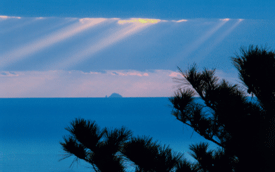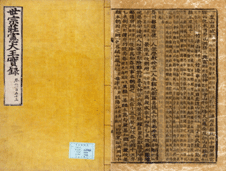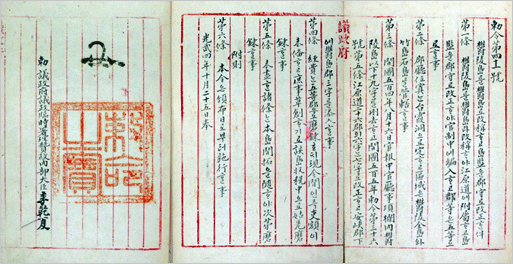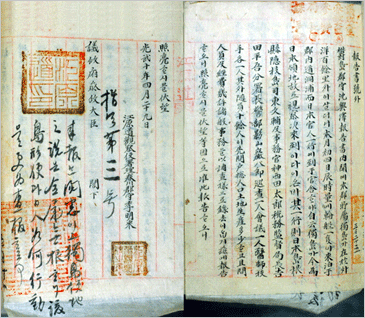DOKDO
DOKDO & EAST SEA LIVE
Basic Position of the Government of the Republic of Korea on Dokdo
The Government of the Republic of Korea is adamant in its position that Dokdo is within Korean territory. The fact that Dokdo is an integral part of Korean territory is irrefutable in every aspect; geographically, historically and under international law.
Geographically, Dokdo, the easternmost islands of Korea, are 87.4 km southeast of Ulleungdo in the East Sea. According to Sejong sillok jiriji (世宗實錄 地理志, Geographical Appendix to the Veritable Records of King Sejong, 1432), compiled on the instruction of the King in the early Joseon period (1392-1897), Usan (Dokdo) and Mureung (Ulleungdo) are not far apart and are visible from each other on a clear day. As if to prove this statement, Dokdo is indeed visible with the naked eye from Ulleungdo in clean weather. It is only natural that the residents in Ulleungdo have long since recognized Dokdo as islands belonging to Ulleungdo.


Moreover, findings from recent research give weight to the high likelihood that people lived in Ulleungdo since the prehistoric era. However, it was not until when the Silla Kingdom (57 BCE-935 CE) annexed Usanguk, a small state comprised of Ulleungdo and Dokdo in year 512, that Dokdo started appearing in official documents. For example, Sejong sillok jiriji referred to Ulleungdo and Dokdo as Mureungdo and Usando, respectively. Other documents include Goryeosa (高麗史, History of Goryeo, 1451), Sinjeung dongguk yeoji seungnam (新增東國輿地勝覽, A Revised Edition of the Augmented Survey of the Geography of Korea, 1530), Dongguk munheon bigo (東國文獻備考, Reference Compilation of Documents on Korea, 1770), Man-gi yoram (萬機要覽, literally the Book of Ten Thousand Techniques of Governance but more commonly known as the Manual of State Affairs for the Monarch, 1808) and Jeungbo munheon bigo (增補文獻備考, Revised and Enlarged Edition of the Reference Compilation of Documents on Korea, 1908). These documents show that Usando was an old name for Dokdo, and was used to refer to Dokdo for at least several centuries until the early 20th century. Thus, it is evident that Dokdo was continuously a distinct part of Korean territory for an extended length of time.
During the reign of King Sukjong (1674-1720) of Joseon, as a result of diplomatic negotiations that had been prompted between Joseon and Japan when An Yong-bok was captured by the Japanese fishermen in 1693, the issue of ownership over Ulleungdo and Dokdo was concluded with Japan issuing a directive in year 1696, prohibiting all Japanese from making passage to Ulleungdo.
During the Meiji period (1868–1912), the Daijokan (太政官, Grand Council of State), then Japan’s highest decision-making body, received a note of inquiry from the Ministry of Home Affairs, about the compilation of land registers for the Shimane Prefecture. Following deliberations, the Grand Council of State issued a directive in year 1877 stating, “Regarding Takeshima (Ulleungdo) and another island (Dokdo), Japan has nothing to do with them.” All this is clear evidence that even in Japan, Dokdo was not considered Japanese territory.

In 1900, the fourth year of Gwangmu (Glorious Valor), under the reign name of King Gojong (1863-1907), the Great Han Empire of Korea(1897-1910) issued Imperial Edict 41 placing Seokdo (Dokdo) under the jurisdiction of Uldo-gun (Ulleungdo), thus reaffirming the fact that the islands belonged to Korea. In 1906, immediately after being notified that the islands had been incorporated to Japanese territory from a Japanese survey team comprised of officials and civilians from the Shimane Prefecture, Sim Heung-taek, the County Chief of Uldo-gun of Korea, submitted a report to the Governor of the Gangwon-do stating that “Dokdo, which is under the jurisdiction of our county….” The submission of such a report is clear evidence that the County Chief of Uldo-gun recognized Dokdo as being within the scope of his administration pursuant to Imperial Edict No. 41.
In 1906, the Uijeongbu (議政府, the State Council of the Great Han Empire), having received the report mentioned above, issued Directive No. 3, arguing that “…that there was no basis for such an act” to instruct a reexamination of Japan’s act of incorporating Dokdo as its territory. This reaffirms that the Great Han Empire was governing Dokdo clearly maintaing sovereignty over the islands.

Nevertheless, Japan, in the midst of the Russo-Japanese War (1904-1905), which had been triggered by Japan’s imperialistic invasion scheme toward Northeast Asia since the 1890s, disseized Dokdo and incorporated the islands into the Shimane Prefecture by issuing the Shimane Prefecture Public Notice No. 40(1905). Japan’s annexation of Dokdo constituted a violation of international law, and cannot be justified under any circumstances, for it is a clear infringement on the undeniable sovereignty of Korea over the islands from ancient times to the recent Great Han Empire. More importantly, Japan’s actions carry no legal validity under international law.
Korea was annexed to Japan in 1910 and the colonial rule ended in 1945 with Japan’s defeat in World War II. In 1943, while the war was still being fought, the three Allied Powers—the United States, Britain and China—issued the Cairo Declaration, vowing that Japan would “…be expelled from all other territories which she has taken by violence and greed.” In 1945, when Korea regained its independence, Dokdo, too, was returned to Korea as a matter of course. Moreover, while the United States Army Military Government in Korea (USAMGIK) temporarily ruled the country after liberation, Dokdo was excluded from those territory controlled and administered by Japan in accordance with the Supreme Command for Allied Powers Instruction (SCAPIN) No. 677. Later, Dokdo’s exclusion from Japan’s territory was reaffirmed by the Treaty of Peace with Japan, better known as the San Francisco Treaty, of September 8, 1951. In the years following Korea’s liberation from Japan and to this day, Dokdo has been under the effective control of Korea. In this light, it is clear that sovereignty over Dokdo has always been with Korea.
The Government of the Republic of Korea’s position is steady that Dokdo has inherently been Korean territory. The Government does not regard the Dokdo issue as a matter to be dealt with through diplomatic negotiations or judicial settlement. The Government will deal firmly and resolutely with any claims denying Korean sovereignty over the islands. Also, the Government will take a firm and coolheaded approach, based on objective and effective measures which will be more convincing to the international community.



 INTERNATIONAL
INTERNATIONAL

